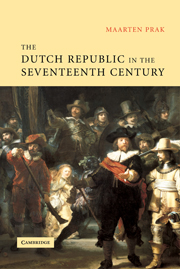Book contents
- Frontmatter
- Contents
- List of illustrations
- Acknowledgements
- Chronology
- Map
- Introduction: The enigma of the Republic
- 1 A turbulent beginning
- Part I War without end
- Part II Golden Age: economy and society
- Part III Unity and discord: politics and governance
- Part IV An urban society
- 13 Religious pluralism
- 14 A new approach to science and philosophy
- 15 The Dutch school of painting
- 16 The urban landscape
- Conclusion: The end of the Golden Age
- Further reading
- Index
14 - A new approach to science and philosophy
Published online by Cambridge University Press: 05 February 2015
- Frontmatter
- Contents
- List of illustrations
- Acknowledgements
- Chronology
- Map
- Introduction: The enigma of the Republic
- 1 A turbulent beginning
- Part I War without end
- Part II Golden Age: economy and society
- Part III Unity and discord: politics and governance
- Part IV An urban society
- 13 Religious pluralism
- 14 A new approach to science and philosophy
- 15 The Dutch school of painting
- 16 The urban landscape
- Conclusion: The end of the Golden Age
- Further reading
- Index
Summary
Anthonie van Leeuwenhoek was fascinated by the invisible. With his microscopes he examined plants, offal and the remains of meals picked from his teeth. The Grand Pensionary Anthonie Heinsius, an old friend from Delft, once received a letter from Leeuwenhoek containing a detailed description of the life that had sprung up between his toes during a two-week period in which he never changed his stockings. Leeuwenhoek also examined his own excrement and semen, and was one of the first to describe the development of spermatozoa – ‘little animals’, as he called them – and to analyse their role in reproduction. Leeuwenhoek, the first man in history to see bacteria, had gained access to the invisible world through his superior microscopes.
Enlargement was a speciality of the Dutch. In September 1608 the Middelburg spectacle-maker Hans Lipperhey gave a demonstration to Stadholder Maurits of ‘a certain instrument for seeing far’, for which he had applied for a patent. At the same time, Jacob Metius in Alkmaar invented the same instrument independently. The very next spring, telescopes were being sold in Italy, and the astronomer Galileo Galilei built from the Dutch example a telescope of his own, with which he studied the surface of the moon and discovered that it was full of mountains and craters. Using an improved telescope, the famous Dutch scientist Christiaan Huygens discovered in 1655 that Saturn had a satellite – later named Titan – and ascertained a year later that Saturn was surrounded by rings.
- Type
- Chapter
- Information
- The Dutch Republic in the Seventeenth CenturyThe Golden Age, pp. 222 - 233Publisher: Cambridge University PressPrint publication year: 2005



